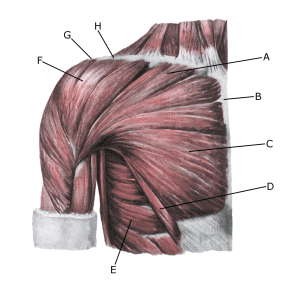Anatomy

The pectoralis major muscle (M pectoralis major) is fan-shaped and covers the front of the chest wall and attaches to the humerus (crista tuberculi majoris). The function of the pectoralis major is, among other things, to bring the arm towards the body and to flex and internally rotate the shoulder (as in throwing). The large pectoral muscle forms the anterior fold of the armpit (anterior axillary fold).
Skulder- og overarmsmuskler, set forfra:
A. M. pectoralis majo
B. Sternum
C. M. pectoralis major
D. M. pectoralis major
E. M. serratus anterior
F. M. deltoideus
G. Acromion
H. Clavicula
Cause
When a muscle is subjected to a load that exceeds muscle strength (strength training, weight lifting, wrestling, falling), a tear occurs. The vast majority of tears in athletes are total tears. Total tears are usually localised in the muscle tendon at the attachment of the humerus. Partial tears (‘fibre tears’) are usually located in the muscle itself.
Symptoms
In mild cases, a localised soreness is felt after the load (‘muscle strain’, ‘threatening fibre’).
In more severe cases, a sudden shooting pain is felt in the muscle (‘partial muscle rupture’, ‘fibre rupture’) and in the worst case, a violent snap is felt, after which it is impossible to use the muscle (‘total muscle rupture’).
In muscle injuries, the following three symptoms are characteristic: Pain on pressure, stretching and activation against resistance. In total tears, a defect can often be seen and felt in the muscle at the anterior fold of the armpit and there is often bleeding in the subcutaneous tissue (‘bruising’).
Examination
The diagnosis is usually made on general clinical examination, where there is pain and reduced strength when the arm is squeezed against resistance (adduction) and when the muscle is stretched. For more severe, sudden onset pain and severe difficulty using the arm, an examination should be performed by a professional and supplemented with an ultrasound scan (possibly an MRI scan).
Treatment
In athletes with total tears localised to the attachment of the humerus, most recommend surgery, which can be performed within the first few months (Magone K, et al. 2023). For partial tears and tears localised in the fleshy part of the muscle, offloading and gentle rehabilitation is recommended (Long MK, et al. 2022). In the case of total tears, a rehabilitation period of several months must be expected before maximum load can be resumed.
Rehabilitation
Rehabilitation is of course dependent on the degree of rupture and the treatment (conservative/surgical). It is advisable to wait for strength training for the first few months and then resume it with a very low load to avoid tearing the muscle again.
Complications
If the progress is not smooth, you should consider whether the diagnosis is correct or if there are complications.
In particular, the following should be considered:
- Total rupture of the upper scapula muscle
- Rupture of the biceps tendon
- Luxation of the joint between the shoulder blade and the collarbone
- Luxation of the shoulder joint
- Meniscus lesion in the shoulder
